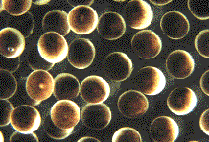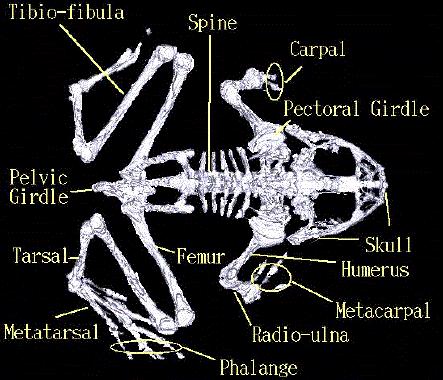Amphibia
Amphibia refers to "double life", or life in water and on land
Includes the salamanders, frogs, toads, and caecilians with approximately 3,900 spp.
Characterized by:
 The name amphibian means "double life", and is given to members of this group for the double life that they lead. For while adult amphibians usually live on land, their soft eggs must be laid in the water. The eggs shown at left have just been shed by the female. This means that they have not yet been fertilized; the male sheds sperm over the eggs after they have been released into the water.
The name amphibian means "double life", and is given to members of this group for the double life that they lead. For while adult amphibians usually live on land, their soft eggs must be laid in the water. The eggs shown at left have just been shed by the female. This means that they have not yet been fertilized; the male sheds sperm over the eggs after they have been released into the water.
Young amphibians, like the larval frog or tadpole pictured here, spend their early years in the water, breathing through gills in the side of their head in much the same way as fish do. In many ways they resemble fish more than they resemble their parents, for they have no legs, and swim by wriggling their tail. As they mature, amphibians will usually lose their gills and develop legs. A number of salamanders, such as the North American "mudpuppy" and the Mexican axolotl, develop legs but retain their larval gills and stay in the water throughout their lifetimes. This is a classic example of an evolutionary phenomenon known as neoteny -- the retention of larval or juvenile features in mature adults.

Most amphibians have soft skin which easily absorbs water. This puts them in very close contact with their surroundings. It also makes them particularly susceptible to certain man-made toxins and pollutants. This may be why the number of amphibian species, and the size of many amphibian populations, has been declining in recent years. Amphibians, like the proverbial "canary in a coal mine," may be among the first organisms to suffer from the effects of global pollution and climate change -- providing an early warning of environmental degradation.
Includes the salamanders, frogs, toads, and caecilians with approximately 3,900 spp.
Characterized by:
- Being tetrapods (4 limbs) that facilitate moving about on land - these limbs evolved from the pectoral and pelvic fins
- Skin is thin, soft, glandular and magid (lack scales except in the caecilians) - skin of caecilians with scales similar to those of fish
- Ectothermic
- Both gill and lung breathers - usually gills in the larval stage, replaced by lungs in the adult; cutaneous respiration in many
- Three-chambered heart with two atria and one ventricle
- fertilization may be internal or external
- egg-layers (oviparous) but may have modifications associated with development
- egg anamniotic - doesn't have a shell but covered with a series of gelatinous layers
- hatchling in aquatic larval form which breath by gills
- most larvae herbivorous, some omnivorous to carnivorous
- larval stage may last from 10 days to 20+ years
- unable to regulate body temperature
- skin types limit distribution to warm, moist climates (i.e. tropics, subtropics, and temperate zones)
- most US species in the south; not found in dry areas
- generally limited to freshwater lakes, streams, ponds - none are true marine forms
- Subclass Labrinthodontia - looked like a salamander
- represented by genus Ichthyostega (fish with feet or legs)
- identified by specific labronthodont tooth
- Subclass Lepospondyli
- named for vertebral type with three fused parts
- Subclass Lissamphibia - contains all living specimens
- where living amphibians evolved is not clear - modern (living) amphibians appeared in Triassic
Life History and Ecology
 The name amphibian means "double life", and is given to members of this group for the double life that they lead. For while adult amphibians usually live on land, their soft eggs must be laid in the water. The eggs shown at left have just been shed by the female. This means that they have not yet been fertilized; the male sheds sperm over the eggs after they have been released into the water.
The name amphibian means "double life", and is given to members of this group for the double life that they lead. For while adult amphibians usually live on land, their soft eggs must be laid in the water. The eggs shown at left have just been shed by the female. This means that they have not yet been fertilized; the male sheds sperm over the eggs after they have been released into the water.Young amphibians, like the larval frog or tadpole pictured here, spend their early years in the water, breathing through gills in the side of their head in much the same way as fish do. In many ways they resemble fish more than they resemble their parents, for they have no legs, and swim by wriggling their tail. As they mature, amphibians will usually lose their gills and develop legs. A number of salamanders, such as the North American "mudpuppy" and the Mexican axolotl, develop legs but retain their larval gills and stay in the water throughout their lifetimes. This is a classic example of an evolutionary phenomenon known as neoteny -- the retention of larval or juvenile features in mature adults.

Morphology

Shailesh kr Shukla
directoratace@gmail.com
No comments:
Post a Comment